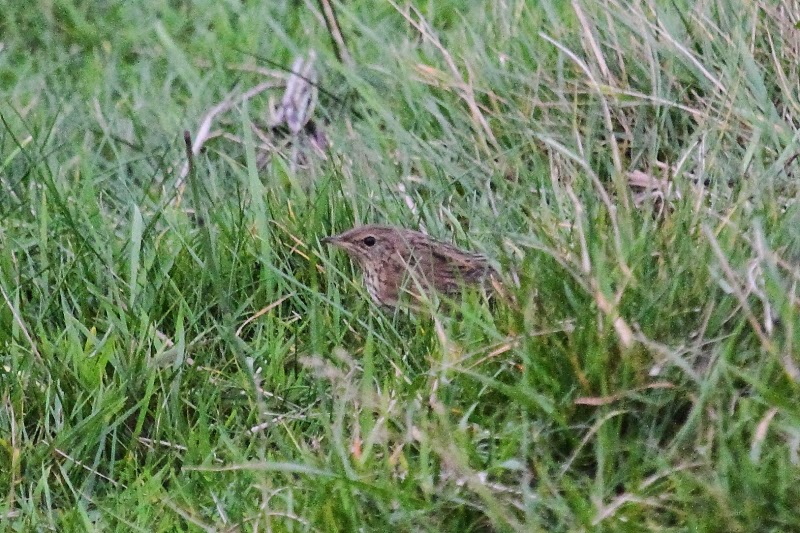I woke up the next morning slightly bleary eyed after quaffing some fine single malt in celebration of our find the evening before and packed my bags ready for the off... This was our last day on Shetland and we had to get down to Quendale to nail that Lancy for sure, so after packing our gear in the van we made our way to the south of the island and arrived at Quendale with the news that people had already been up, seen the bird and confirmed it was a Lancy, but we wanted to make sure for ourselves.
As we made our way up the burn we found the group of birders who seemed to be watching a patch of irises.... good stuff, they'd got it pinned down OK then.... we made it to them and I was introduced to Adrian Kettle who showed me a picture of the Lancy that he'd taken earlier showing the tertial pattern.... that nailed it. Totally and utterly.... the clean, crisp brown edge to the tertials.... longer than the secondaries.... bang on for Lancy. We follwed the bird around a while and got some absolutely stonking views of it sat out on a tussock of grass. I grabbed some shots and, on reviewing them, saw that I'd got the undertail coverts in the photo... pale with dark streaks.... the tertial pattern was there too.... brilliant... that ticked everything to be able to put in a full and nailed on description to the British Bird Rarities Committee.
 |
| Lanceolated Warbler (Locustella lanceolata), Quendale, Mainland |
Eventually the bird settled down in a patch of irises and sat right on the very edge of the iris bed in the open for several minutes only 15 foot away giving all of us the opportunity to see every detail through our bins. It was great to put the ID to rest for ourselves but we would certainly have preferred views like that the night before.
 |
| Lanceolated Warbler (Locustella lanceolata), Quendale, Mainland |
We wandered back down to the tea-rooms to get a celebratory cup of coffee with a few other guys who had made it down like Adrian Kettle, Andy Lawson and Garry Bagnell (which was very kindly paid for by Garry as thanks for finding the bird - his 500th BOU species) and discussed what the plan of action was next.
 |
| Post-Lancy celebratory cuppa. |
We arrived at Levenwick and decamped but the peace was soon shattered as a pager message came up saying there was another White's Thrush, this time by the south exit to the main road of Levenwick! Fred Fearn was with us and this was his main bogey bird, so he shot off in search of it.... the rest of the guys heading off to help. I decided that I wanted to stay with the Rubythroat and try to get some better pictures so I joined the crowd (of 5!!), including Rebecca Nason and Jim Nicolson and settled in to wait for the Rubythroat to show again..... It didn't take long as per usual and it had obviously got used to people..... It showed unbelievably well... staying in the open for quite some time before running back into the undergrowth. It did this several times and even showed down to 10 foot (unfortunately hidden behind the undergrowth but amazing through the bins!) and I can't complain with the images I got...
 |
| Siberian Rubythroat (Luscinia calliope), Levenwick, Mainland |
 |
| Siberian Rubythroat (Luscinia calliope), Levenwick, Mainland |
What a bird.... most definitely the highlight of the autumn for me... no matter what else turns up.
After a while the guys came back to pick me up with the news that there was no-one around where the White's had been reported from and no sign of the bird either.... The directions to the bird were horrifically vague and with nobody around there was very little hope of finding it... We even started thinking that it could have just been a misidentified Song Thrush as there a small flock of Redwings and Song Thrush in the field next to the southern exit and the guys had got up there within 2 minutes of the report coming out. Who knows.... The rest of my group decided it was time to move on to the south of the island in readiness to catch their flight later on, but as Fred was staying for a few more days, needed the White's and I was catching the ferry later, I stayed with him and scoured the area. We checked every garden and every ditch we could find before finally having to accept that the bird had either moved on. We did find a female Black Redstart in the corner of on of the fields though which was a pleasant surprise.
 |
| Black Redstart (Phoenicurus ochruros), Levenwick, Mainland |
It was almost time to catch the ferry back to Aberdeen but we still had to quickly check Seafield at the back of Tescos in Lerwick. There wasn't much there but a Brambling showed beautifully in the sunshine.
 |
| Brambling (Fringilla montifringilla), Seafield, Mainland |
It was then time to say goodbye to Shetland for another year.... how on earth this year can be beaten is beyond me... we ended up seeing 8 BB rarities, I had 2 new self-found birds in Lanceolated Warbler and Bluethroat, 5 lifers in the form of Rustic Bunting, White's Thrush, Myrtle Warbler, Pallid Harrier and Siberian Rubythroat and plenty of memories that will stay with me for a long time to come. Shetland is a very special place and I can't wait to be back next year!!
 |
| The last goodbye |

























